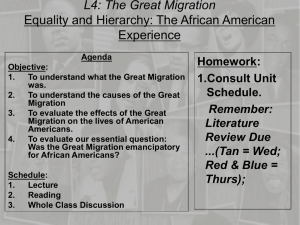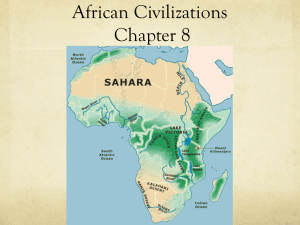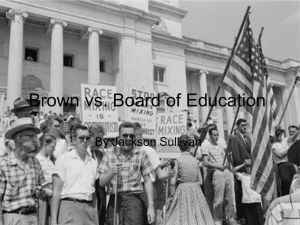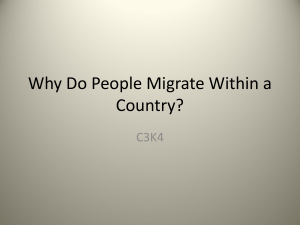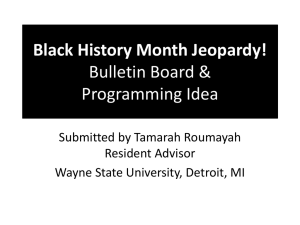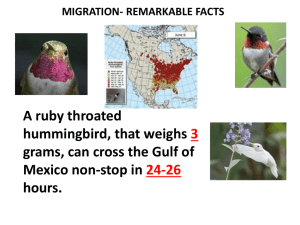The Great Migration - Ms. deMink`s English Class
advertisement
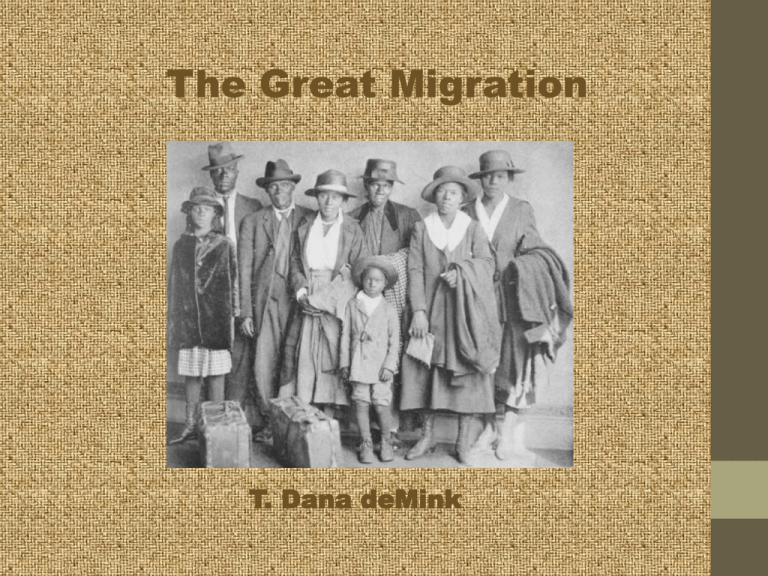
The Great Migration T. Dana deMink Goals • This activity is for a high school level English Language Arts class. • This presentation is about The Great Migration. It provides the historical background of events leading to The Great Migration, and is the introduction to a unit on The Harlem Renaissance. • The goals is for students to learn about the causes of The Great Migration from The Emancipation Proclamation forward. • These goals are part of the Michigan Education Standard Benchmarks for English Language Arts Content Standard 5(3); 5(4); 5(5). What is the Great Migration? • The Great Migration was a massive relocation of African Americans from the rural Southern states to cities of the North. • The First Wave: 1910 to 1930 (1.6 million people). After 1930 the migration slowed down a bit because of the Great Depression (1929 to the early 1940’s). • Second Wave: 1940 to 1970 (5 million people). The U.S. entered the Second World War in 1941. • What does “Diaspora” mean? The movement of people from their homeland to somewhere else. • This presentation will concentrate on The First Wave They came from… Alabama Mississippi (To name a few States…) Louisiana And went to… New York St. Louis As well as Philadelphia, Pittsburgh, Cleveland, Indianapolis Detroit Why is the Great Migration Important To This Class? • We just finished reading Booker T. Washington’s Up From Slavery; as well as selected readings from W.E.B. DuBois. • This is our lead in to The Harlem Renaissance (1918 to 1937), the most influential movement in African American artistic/cultural history. • The Great Migration provides the historical background for our next writers, James Weldon Johnson, Zora Neal Hurston, and Langston Hughes. • Like it or not, you are going to get some history in your English classes! Why did African Americans leave the South? Let’s Go Back in the Time Machine… • The Emancipation Proclamation was signed in 1863. Four million people, poor, displaced, and mostly illiterate, are free but homeless. • The Civil War did not end until 1865 (it started in 1861). Some “freedmen” ran to the Union army for protection. The Union army didn’t know what to do with these “refugees,” it could barely care for its own troops. Many freed slaves died of diseases in the Union stockades. • Many took to the roads in search of work, sometimes traveling over mountains with little more than their clothes. Do you recall what happens to Booker T. Washington’s family when they are freed? • The Plantation-based economy was in ruins. Many freed blacks returned to the plantations as sharecroppers. Sharecroppers plowed, weeded and harvested land owned by others for a small share of the crop. Their lives were virtually the same as in slavery, but they were able to keep their families together. • Many were so poor that they went in to debt to their former white owners (or to the farm owners) to pay for food, clothing, shelter etc. Despite their apparent freedom, African Americans received little protection in the South. To a certain extent, they took one step forward and two steps back. Reconstruction was a failure… • The Civil Rights Act of 1875 guaranteed African Americans equal treatment in public places, public transportation, and prohibited exclusion from jury service. The law was hardly ever enforced and The Supreme Court decided the act was unconstitutional in 1883. • The Freedman’s Bureau, was established by Congress in 1865 to help former black slaves and poor whites following the Civil War. The Freedman’s Bureau provided food, housing, medical aid, and established industrial schools. Due to limited funds, and political corruption, the Bureau was shut down in 1872. Go back to the Quiz Reconstruction was a failure…. • Many southern Democrats began to make informal agreements with the Republicans behind closed doors. In the Compromise of 1877, the Republicans promised that if Rutherford B. Hayes was elected they would withdraw the last of the federal troops from the south. When this happened, the period known as Reconstruction, was over. • “Black Codes” or local statutes came in to play. White southern leaders re-took control over former Confederate States. These codes were designed to “keep Blacks in their place.” These local statutes (no loitering, no unemployment, no being out “past curfew,” no indebtedness, no voting, no relations with White women) only increased the power of the Ku Klux Klan. • Founded in 1866, the Ku Klux Klan rose up from the tradition of Slave Patrols. The KKK served to push the freedmen back to the plantation. Unlike slave patrols, the Klan worked outside of the law through the use of brutal intimidation tactics. • Their goals were to maintain social order of black population through terrorism; suppress black socioeconomic sufficiency; and maintain the so-called “supremacy” of white class structure. • There were over 2,800 documented victims of lynch mobs from 1882 to 1930 in 10 Southern states. 2,500 victims were Black. On average one Black person died at the hands of an angry White mob one day a week. • In 1898 the boll weevil invaded Texas and ate its way east across the South. Thousands of farm workers were displaced, and the long reign of King Cotton as the region's economic backbone was finally brought to an end. Go Back to the Quiz And Then a Miraculous Thing Happened… World War… • World War I (1914) brought a halt to European immigration. For more than 60 years European immigrants supplied cheap labor to American factories in the North. • The War called for a “beefing up” of arms and supplies. There was a severe labor shortage in U.S. factories • Wars always create an economic “boom.” But with no workers, it was looking like American Industry was going to miss its golden opportunity. • Northern factories began recruiting for workers from the South. Promised Land… • Reports spread of abundant job opportunities in the North. • Recruiters set up stations on street corners in Southern towns. They approached young, strong, men and offered them train tickets. • Recruiters published success stories in local newspapers of those that had traveled to work in the North and were successful. • These stories were read in barber shops and churches. • Soon “Migration Fever” swept through the South. The Journey • They traveled by train, boat, bus, car, and even in horse drawn carriages. • The journey was long and slow. Many stopped to find work along the way. This was called “step migration.” • Fares skyrocketed from $.02 cents per mile in 1915 to $.24 cents per mile three years later. • Travelers were segregated in public transit waiting rooms and en-route. African American travelers could find little to eat or drink on their stops. Did they have a “Happily Ever After?” Not Exactly… • The Migration created housing shortages in urban areas. Banks limit lending to Blacks. Migrants lived in tenement housing. During this time Harlem became the “Black Mecca.” • “Separate But Equal” (Jim Crowe system 1876-1965) becomes common-place. • They were snubbed by existing White immigrant labor groups because they are willing to work for a lower wage. • Race riots (St. Louis) in factories. More About “Separate but Equal”….. • In 1896 the Supreme Court ruled that “separate but equal was constitutional with its ruling in the case Plessy v. Ferguson. • Long story short, Homer Plessy, (a man of mixed ancestry), bought a first class ticket on a train in Louisiana. He attempted to board the “Whites Only” car. Plessy refused to move and was arrested. He claimed that this was in violation of his 13th and 14th Amendment Rights. The Supreme Court upheld the State of Louisiana’s decision to remove and arrest Plessy. Click here to read more about Plessy v. Ferguson. • This decision only cemented the Jim Crowe “Separate But Equal” system and with the new wave of migration to Northern Cities, brought more segregationist practices, such as separate transportation, bathrooms, lunch counters, etc. • One step forward…two steps back! Go back to the Quiz But it was also a time of opportunity….many Southerners flourished in the North • Many go to college in the North and become professionals. • An African American middle class is established. • Jazz music, and other African American artistic expressions blossom and become part of “main-stream” culture. This period is known as the “Harlem Renaissance.” • African Americans begin to “organize”. This period sees the establishment of NAACP in 1909 under the leadership of W.E.B DuBois; the National Urban League (which worked to give employment training to those immigrating from the South.); and the “Back to Africa Movement.” 1. One reason for The Great Migration was: They were running away from slavery It was too hot in the South They didn’t want to farm anymore The economic instability of the South. NO, SORRY. GO BACK TO SLIDE 7 AND KEEP READING! YOU WERE PAYING ATTENTION! GREAT! NOW GO ON TO THE NEXT QUESTION… 2. What was one of the tasks of the Freedman’s Bureau? Clear roads after the Civil War. Establish schools to educate freed African Americans so that they could learn a trade. Rebuild houses in the South. Provide transportation for the Ku Klux Klan. GREAT JOB! NOW GO ON TO THE NEXT QUESTION… 3. Why was the loss of the Plessy v. Ferguson case so devastating to African Americans? It institutionalized the idea of “separate but equal.” The same problems followed African Americans from the South to the North. Even though the goal was “equal” things really weren’t equal. For example, if there was no Black movie theatre in a town, Blacks then had to sit in the back of White movie theatres. All of the above. GREAT JOB! Please read the last slide to complete this lesson. Try again. Take a look at slide 13. This is true, but remember there is only one right answer. Re-read slide 22 and try again. CONCLUSION • Something to think about…what is the common driver that links “The Middle Passage” to “The Great Migration?” • The early settlers needed human labor to clear swamps and farmland in order to grow lucrative cash crops such as cotton, tobacco, and sugar. • During the American Industrial era, the need for low-cost labor was the same. African Americans worked for a low wage in factories in Northern cities. They fueled big industry. Why did they do it? …In the words of Paul Laurence Dunbar in his poem entitled “Sympathy” (1899) “I know why the caged bird sings, ah me, When his wing is bruised and his bosom sore, -When he beats his bars and he would be free; It is not a carol of joy or glee, But a prayer that he sends from his heart’s deep core, But a plea, that upward to Heaven he flings— I know why the caged bird sings!”
